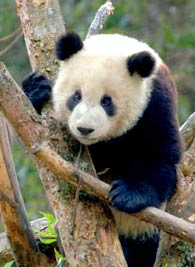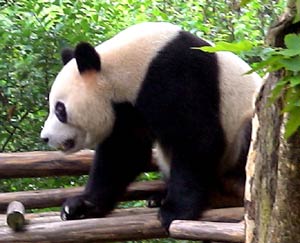The Wolong Panda Reserve Research
Center was set up by the Chinese government back in
1958 to save the declining panda population. The Panda
Reserve is a 3 hour drive from Chengdu. It's a natural
reserve covering over 200,000 hectares., and is the
largest panda reserve in China. Wolong was added to
UNESCO in 1980.
During the past decades since the
development of the Wolong Panda Reserve, artificially
bred baby panda survival rates has increased from
30% to 90% in 2003. Wolong Panda Reserve opened up
wildlife observation areas, and attracts over 100,000
visitors each year. The Wolong Giant Panda Reserve
is also home to other rare and endangered wild animals
such as the golden monkey, gnu (Wildebeest), red panda,
and more.
Giant Panda
The Giant Panda is usually classified
in the bear family, and is native to central and southern
China. The panda's main food is bamboo, but they also
eat other foods such as fish, eggs, and honey. It
is one of the most endangered species in the world
with an estimated 1,600 pandas alive in the wild and
about 160 live in captivity.

Adult pandas have a length of 1.6m
to 1.8m, and weight between 176 to 275 pounds. Giant
pandas have a large head with distinctive black patches
around the eyes, ears, and the body.

Giant pandas are found in mountainous
regions that are dense with bamboo trees in central
and southern regions such as Sichuan and Tibet. Although
classified taxonomically as a carnivore, the giant
panda's diet is mostly herbivorous. They eat almost
entirely bamboo shoots and leafs. Wild pandas get
a large portion of their water needs from bamboo trees
whose contents are about 50% water, and the get the
rest of their water intake from nearby rivers and
water streams.
Pandas reproduce very slowly, and
infant mortality is high - these are major reasons
why it's such an endangered specie. The growth of
panda cubs are slow as well, and they do not reach
sexual maturity until they are 5 to 7 years old. Mating
season for the pandas usually take place from march
to may.
|